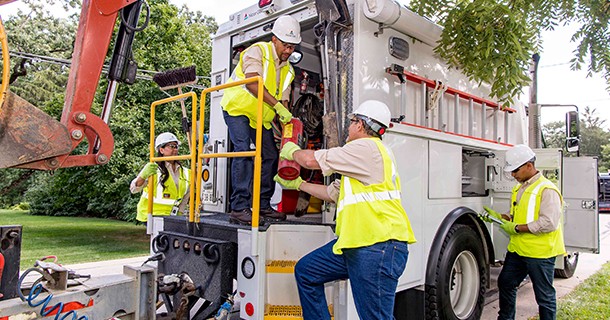Weather Normalization Adjustment for Commercial Customers
About
A commercial or industrial customer served under Rate Schedule 2B or 2C, General Firm Gas Sales Service or Rate Schedule 4, General Air Conditioning Firm Gas Sales Service, may make a request for exemption from the WNA adjustment if their gas usage is not affected by the weather. A study of the usage will determine if the request falls within the approved guidelines.
Why Request a Usage Study?
The WNA is designed to reduce sudden changes or volatility in the customer bill. Volatility is created when a customer’s usage is affected by weather. The WNA accomplishes reduction in volatility by comparing the actual weather that occurred during a billing period to normal weather (defined below) and adjusting the bill to normal weather.
This adjustment is a credit to the bill if the weather is colder than normal and a surcharge to the bill if the weather is warmer than normal. No adjustment occurs in normal weather. Thus the WNA would not be appropriate to apply to a customer’s bill whose usage is process driven rather than weather driven.
If you are a commercial or industrial customer served under Rate Schedule 2B, 2C or Rate Schedule 4 to whom this applies, please contact Customer Care at 866.229.3578, 7 a.m. to 8 p.m., Monday through Friday, or send an email to g2vngcustomercare@southernco.com. Details may be found in Rider C included in VNG Tariff on virginianaturalgas.com.
Weather Normalization Adjustment for Commercial and Industrial Customers
In September 2007, the Virginia State Corporate Commission (VSCC) approved a WNA on an experimental basis for commercial and industrial customers beginning in November 2007. The 2008-09 heating season completed this test period. The VSCC extended the WNA for two more heating seasons with one change. Beginning November 2010, a commercial or industrial customer whose gas usage is process driven rather than weather driven may elect to exempt from the WNA. In February 2011 VNG filed to make Rider C a permanent rider to the tariff.
Normal weather conditions measured in heating degree days (HDD) are based on a rolling 30-year period. For the 2025-2026 heating season normal degree-days will be based on the period from October 1995 through May 2025.
The WNA applies to six bills during the winter heating season typically November through April. Each bill period during that time will have a different WNA factor.
WNA provides weather sensitive customers relief during extremely cold winter weather and the company revenue stability to help plan and schedule system maintenance and improvements that contribute to operational quality and pipeline safety.
View the heating degree-day information for your bill period.
Your WNA factor is not shown, as each customer’s WNA factor is based on individual account gas usage.
Frequently Asked Questions
What is a Weather Normalization Adjustment (WNA)?
A WNA is a factor that helps level out high gas bills due to colder-than-normal weather and low gas bills due to warmer-than-normal weather.
How does the WNA work?
For the 2025-2026 winter heating season normal degree-days will be based on the period from October 1995 through May 2025. No WNA adjustment occurs if these normal weather conditions occur. Weather conditions colder than normal will result in a credit. Weather conditions warmer than normal will result in a surcharge. The WNA factor, based on the individual customer usage and weather conditions during each billing period, will be used to calculate the amount of the WNA credit or surcharge.
Why have a WNA? What are the benefits for customers?
WNA benefits customers in the following ways:
- Customers will receive a credit on their bills during colder-than-normal weather.
- WNA provides Virginia Natural Gas revenue stability, enabling us to better plan and schedule system maintenance and improvements contributing to operational quality and pipeline safety.
Is WNA used in other states?
Yes, many states have approved a weather normalization adjustment for natural gas companies. WNA has a proven track record of working well for both customers and gas companies in many states throughout the country. The use of weather adjustments has grown substantially during the past 20 years and includes many gas companies across the country and in Virginia.
Is the WNA a rate increase?
No. The WNA is designed to be revenue neutral because it reduces bills when the weather is colder-than-normal and surcharges bills when the weather is warmer-than-normal. The calculations used to determine these amounts are based on the method and data approved by the VSCC.
Which customers will see a WNA on their bill?
All participating customers served under Rate Schedule 2B, 2C, or Rate Schedule 4 will see a WNA on their bills during the WNA billing period, typically November through April.
When will a customer see a WNA on the bill?
WNA is effective for six billing periods during the heating season beginning with billing cycle 10 in November. Billing cycles 10–21 will have a WNA on their bills November through April and billing cycles 1-9 will have a WNA on their bills December through May.
How is the Weather Normalization Adjustment (WNA) on my bill calculated?
A WNA factor adjusts your delivery charge during the winter months for fluctuations in normal weather. The factor is based on the individual customer's weather sensitive portion of their bill, defined as all usage in excess of each customer’s non-weather sensitive usage or base use. Base Use is defined as the average daily consumption during designated summer months. CCF (hundred cubic feet) of natural gas used and weather conditions (heating degree-days) during each bill period, is used to calculate the amount of your WNA bill credit or surcharge. The actual heating degree-days in each bill period are compared to the normal heating degree-days for the period to determine if the weather is colder or warmer than normal.
For the 2025-2026 heating season normal degree-days will be based on the period from October 1995 through May 2025. Heating degree-days are calculated by subtracting the average temperature for the day from 65 degrees Fahrenheit - 65 degrees is considered the base temperature at which most homes and buildings would be comfortable. Heating degree-days statistics provided by the National Oceanic and Atmospheric Administration (NOAA), a government agency that tracks weather conditions, are used to calculate the WNA factor.



